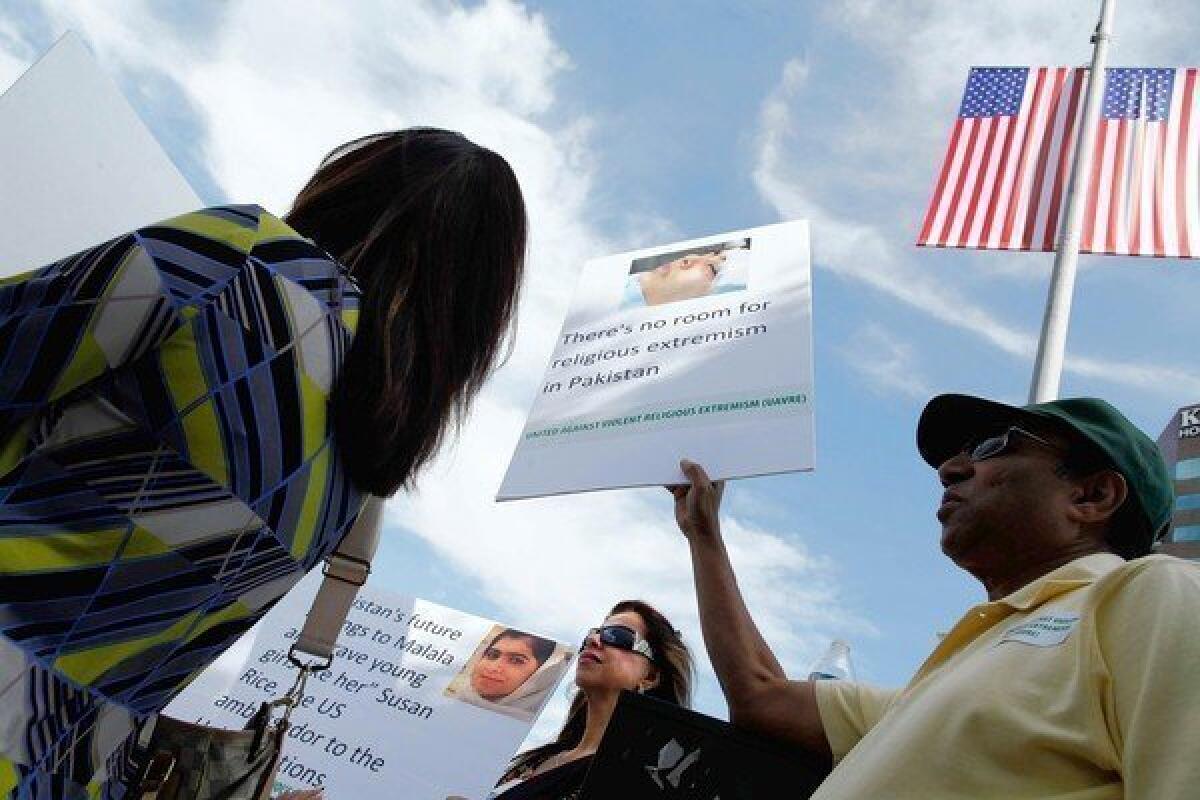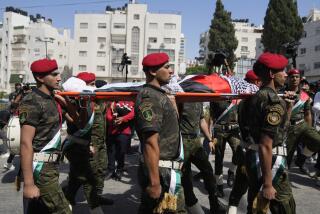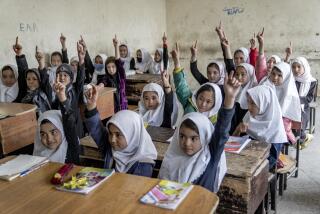Wounded Pakistan teen is now face of girls education movement

- Share via
Malala Yousafzai did not trade in her modest head scarf for a pair of skinny jeans. She wanted to go to school.
For that, the Taliban tried to kill her. When her attackers learned that the freckled 14-year-old Pakistani might survive, they promised to finish the job. Malala, they explained, had been “promoting Western culture.”
The Taliban has committed all manner of atrocities over the years, many of them aimed at women. This time, the militants created an icon for a global movement — for the notion that the most efficient way to propel developing countries is to educate their girls. The idea has been flourishing in some of the world’s most destitute and volatile places. Today, courtesy of the Pakistani Taliban, it has a face.
“People think ‘Western values’ is wearing jeans and sipping pop. Malala was doing none of that,” said Murtaza Haider, a Pakistan native and the associate dean of research and graduate programs at the Ted Rogers School of Management at Toronto’s Ryerson University. “All she said was: ‘Would you be kind enough to reopen my school?’ This is what the Taliban thinks is a ‘Western value.’ This is not a Western value. This is a universal value.”
Pakistan’s Swat Valley, where Malala grew up, is rich in agriculture and minerals, and ringed like a halo by mountains with perennial snow. There are falcons and peridot-colored lakes, and, for a time, there was the country’s only ski resort. Queen Elizabeth II visited in the 1960s.
Then, in 2003, came an arm of the Taliban, which imposed strict religious law, as it had in neighboring Afghanistan. Music was banned. Men would wear beards. And girls would no longer go to school.
This last bit did not sit well with Malala. When she was all of 11 years old, she started a diary about life under the Taliban’s thumb.
Entries in that diary were published by the BBC. Malala became something of a celebrity, featured in documentaries, insisting to visiting journalists that she still had rights — “to play,” she said, “to sing.” Most of all: “I have the right of education.” She knew she was risking her life, telling a reporter at one point that if the Taliban tried to kill her, “I’ll first say to them: ‘What you’re doing is wrong.’”
The communications revolution that is the hallmark of Malala’s generation has not yet lived up to its promise of transforming the world economy. But it has ushered in an age of instantaneous, worldwide conversation. When replacement referees in the NFL bungle crucial calls, the debate is won at the moment it begins, and the regular refs are promptly brought back in. When politicians dismiss half the country as “victims” or deliver a lackluster debate performance, the public verdict is delivered swiftly.
Malala lived in one of the few places where that conversation still doesn’t resonate. But she had unwittingly tapped into that revolution — and was back in school when she was shot and critically wounded last week. She didn’t know it, but she had a voice powerful enough to contest the Taliban.
Years before she was born, anecdotal evidence collected by development programs suggested the importance of educating girls. Knowledge in girls’ heads often meant money in their pockets. And women tended to invest not in themselves, but in their communities — in healthcare, for instance, or nutrition.
Researchers developed metrics to measure the effect. Educated women were more skilled and could make more money, but they also married later and raised healthier children. They had lower rates of disease. Extrapolate from there and the results ballooned from primary education to more efficient local government, even democratic reform.
That movement has caught fire.
In 2009, the book “Half the Sky: Turning Oppression into Opportunity for Women Worldwide” made the compelling argument that this is the defining social issue of the 21st century, as rejecting slavery defined the 19th and fighting totalitarianism defined the 20th.
The book spawned a television series that aired this fall. A film, “Girl Rising,” documenting the struggles of girls seeking an education, is to arrive in theaters next spring and air on CNN. The movie is the centerpiece of 10x10, a global action campaign for girls education.
Secretary of State Hillary Rodham Clinton has steered the weight of the U.S. government toward the issue, and more foreign aid has been earmarked for girls education. Corporate partners have signed on to the cause.
“It’s just that moment, the moment when you put your finger on the pulse of the problem,” said Maro Chermayeff, executive producer of “Half the Sky’s” outreach effort. “People are starting to understand that incredible untapped potential: the army of change that girls can be.”
Richard Robbins, director of “Girl Rising,” now has a photo of Malala on his desk in Los Angeles. Traveling to Haiti, Sierra Leone and elsewhere for the film, Robbins said he found that girls encountered a host of obstacles to education: geographic isolation, for instance, or the sense that school is not a good investment because there’s no job at the other end.
“But there are very few people in the world now who are actually against education,” Robbins said. “This idea that it’s dangerous for a girl to have knowledge — this is the last gasp of that idea, which was pretty prevalent 200 years ago, everywhere in the world.”
There is always room for cynicism in Malala’s corner of the world. Pakistan has blown numerous opportunities to combat extremism. With the planned withdrawal of Western troops from Afghanistan, some see an opening for more Taliban influence in the region, not less. As one Pakistani journalist tweeted: “For everyone who seems to think Malala’s assassination attempt is some ‘moment’ — Pakistan had lots of them and guess what happened? Nothing.”
But even some hardened observers see suggestions of lasting effects. Women have protested with signs assailing the Taliban by name — unthinkable in some pockets of Pakistan. Few thought that a promised reward for information leading to Malala’s assailants would do any good. On Friday, police announced that several men had been detained.
“There’s definitely international condemnation, but in equal amount there’s condemnation in Pakistan,” said Shamila Chaudhary, a former director for Pakistan and Afghanistan at the White House National Security Council, now a senior South Asia fellow at the New America Foundation.
Some believe the attempt to kill Malala could propel the girls education movement into the Swat Valley — and then, perhaps, pose an existential threat to the Taliban.
Shabana Basij-Rasikh attended college in the U.S. and has returned home to Afghanistan to open one of that nation’s first boarding schools for girls. Students who live in regions under Taliban control attend in secret, she said. Some hide their school books in grocery bags, just as she did when she grew up under Taliban rule.
“What Malala has achieved, the military could not,” Basij-Rasikh said.
More to Read
Get the L.A. Times Politics newsletter
Deeply reported insights into legislation, politics and policy from Sacramento, Washington and beyond. In your inbox three times per week.
You may occasionally receive promotional content from the Los Angeles Times.











